Supplementary sheet Nutrition Education at different stages of life
DOI:
https://doi.org/10.56294/sctconf2022247Keywords:
Nutrition Education, Food, Life Stage, Health Promotion and Disease PreventionAbstract
Introduction: hundreds of millions of people suffer from diseases resulting from excessive or unbalanced diets, and many countries are currently facing serious nutritional health problems, morbidity and mortality due to non-communicable diseases are increasing. Nutritional education of the population is required; the observatory of food sovereignty and nutritional education is created to empower decision-makers with knowledge so that they can have at the right time the necessary data to document their decisions.
Aims: to elaborate a supplementary sheet on nutritional education in different stages of life, which can be used by students and professors of the medical career.
Methods: theoretical methods were used with documentary review, updated on the subject in magazines, books and basic bibliography of the subjects of General Comprehensive Medicine, historical-logical analysis, health education techniques are combined; a structure of introduction, four chapters and bibliography was left.
Results: emphasis is placed on the promotion of adequate nutritional diets at different stages of life, applying health education techniques with messages and images of healthy eating, with an introduction on nutritional education, each chapter deals with this topic at different stages, chapter I - pediatric age; II - pregnant women; III - older adults; IV - some non-communicable diseases and bibliography.
Conclusions: nutritional education is an educational strategy that leads to improve the health status of the population, it responds to the government management model based on science, technology and innovation.
Downloads
Published
Issue
Section
License
Copyright (c) 2022 Gicela Díaz Pita, Iván Bustinzuriaga Marto, Idicelis Corría Martínez, Juan Miguel Santaya Labrador, Aliosmi Cordero González (Author)

This work is licensed under a Creative Commons Attribution 4.0 International License.
The article is distributed under the Creative Commons Attribution 4.0 License. Unless otherwise stated, associated published material is distributed under the same licence.



